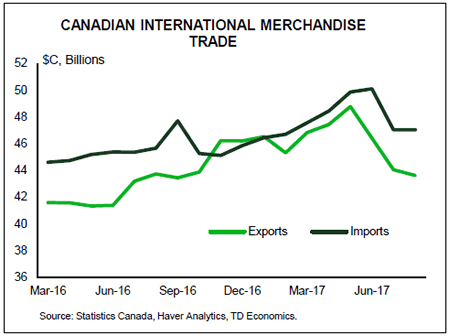U.S. Highlights
- U.S. equities this week managed to recover from earlier losses following strong earnings and a series of upbeat economic data. Durable goods orders and new home sales surprised to the upside, while the House approved a budget plan, adding to the upbeat tone.
- The advance estimate for third quarter GDP growth of 3% (annualized) came in better than expected despite hurricane impacts weighing on domestic demand.
- The ECB announced a reduction in its pace of asset purchases and extended its bond-buying program through September 2018 or beyond if necessary, acting to affirm a growing policy divergence between the ECB and the Fed.
Canadian Highlights
- Economic data was generally constructive this week, with wholesale trade up in August and a solid payrolls report.
- Finance Minister Morneau delivered his fall economic and fiscal update, which sees an improved budget balance resulting from recent strong economic growth. He elected to ‘split the difference’, with about one-third of the gain used for new initiatives and the remainder allowed to flow through to a reduced deficit profile.
- The Bank of Canada maintained its policy rate at 1.00%. The accompanying discussion took a dovish bent, but the growth outlook remains consistent with further monetary tightening. ‘Data dependency’ likely means that the Bank will seek confirmation of the growth path before further tightening, making January 2018 the most likely trigger point for another hike..
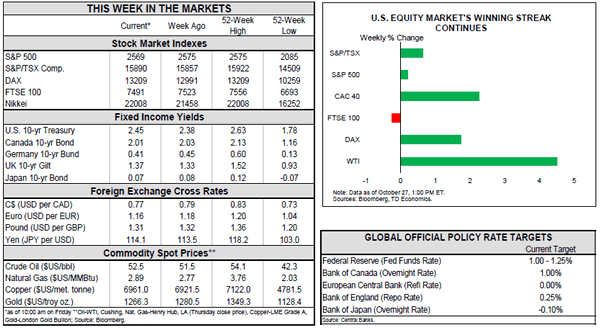
U.S. – U.S. Economy Steams Ahead at 3% Pace
Stocks gained this week on the back of strong earnings reports and on upbeat economic data. Durable goods orders rose 2.2% (m/m) in September – more than double the expected rate, while new home sales surged an impressive 18.9%. Although the latter can be partially attributed to a rebound in hurricane-hit areas, improvements were recorded in all regions, as activity was likely boosted by significant inventory shortages in the existing home market. The passing of a budget plan in the House, another step forward toward tax reform, added to the upbeat tone and proved particularly beneficial to Treasury yields and the U.S. dollar.
The most anticipated report of the week, BEA’s advance GDP estimate, reflected this positive momentum. Growth for the third quarter came in much better than anticipated, with the economy expanding at 3% (Q/Q annualized) despite hurricane impacts. The latter did appear to weigh on a few categories, such as services spending and both residential and non-residential construction, all of which dragged on domestic demand (Chart 1), although inventory restocking helped provide some offset. Net trade also contributed positively to growth, but likely reflected a hurricane-related fall in imports, suggesting some giveback ahead. Still, with rebuilding likely to lift fourth-quarter economic growth via a rebound in domestic demand, another print of around 3% appears to be in the cards. Given estimated trend growth of 2.0%, another quarter of above trend growth is consistent with a continuation of the current interest rate hiking cycle. As such, a December rate hike appears very likely, provided that we also see some cooperation from inflation metrics.
Beyond 2017 however, the interest rate path is more uncertain. This is not only due to evolving growth and inflation dynamics, but also a possible radical makeover of the Fed, which has a number of open Board of Governor positions and may soon get a new Chair. Among the frontrunners for the top position, former Fed Governor Kevin Warsh and Stanford professor John Taylor are regarded as somewhat of a challenge to the status quo, given their apparent preference for a more rules-based approach to setting interest rates. The current Fed under Chair Yellen views monetary policy rules more as guideposts and argues against a mechanical approach, the shortcomings of which include the failure to capture current cycle dynamics and the difficulty in measuring the input variables. The latter can lead to significantly different paths (Chart 2). Nevertheless, in the event that a strict rules based approach to monetary policy is implemented, it would point to a faster pace of interest rate normalization.
A number of humdrum central bank meetings took place this week, with Canada, Sweden and Norway keeping rates on hold. In contrast, the ECB meeting was more eventful as it announced an open-ended extension of its asset purchase program through September 2018 and a reduction in its pace of asset purchases to €30B/month starting in January 2018 from the present €60B pace. However, monetary policy is likely to remain loose in the Euro Area for some time as it lags the U.S. on both the inflation and employment front. This divergence in monetary policy is likely to remain a key driver of exchange rate moves for the foreseeable future.
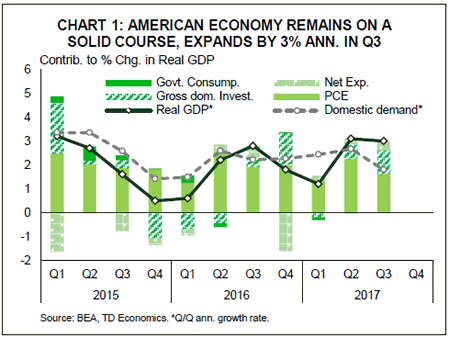
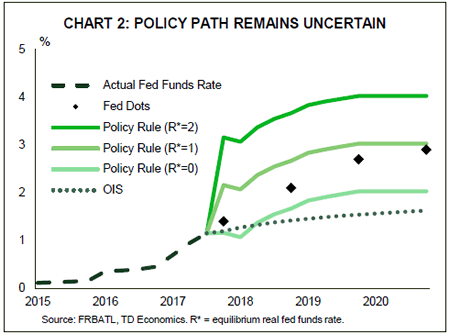
Canada – Morneau Splits The Difference, Poloz Pauses
The past week saw limited, but generally positive economic data. Wholesale trade gained 0.5% in August, driven largely by rising volumes (+0.4%), while the lesser-known payroll employment report showed a rise of 38.9k net positions. The report also pointed to a small climb in average hours worked, a positive sign for economic output, although earnings growth remained somewhat soft.
The main events of the week were not to be found in Statistics Canada data, but rather on or near Parliament Hill. Minister Morneau delivered the fall economic and fiscal update late Tuesday afternoon. The robust performance of the Canadian economy of late translated into an improved fiscal position, reducing the deficit outlook by about $9bn per year through fiscal 2021-22 – a marked improvement, although not enough to bring balanced budgets into view. What’s more, rather than ‘banking’ this improvement, a number of initiatives will use up part of the space. These include reduction in the small business tax rate to 9%, as well as the inflation indexation of the Canada Child Benefit next year (two years earlier than planned), and the expansion of the Working Income Tax Benefit. All told, over a five-year horizon, about one-third of the improvement in the fiscal outlook is expected to be absorbed by these measures (Chart 1), leaving small (<1% of GDP) deficits across the horizon.
Wednesday morning saw the Bank of Canada’s interest rate decision and publication of its quarterly Monetary Policy Report. In the event, Governor Poloz elected to maintain the Bank’s overnight interest rate at 1.00%, with an accompanying statement and report that were, on their face, fairly dovish. Four key areas of concern were again emphasized: potential labour market softness, as seen in wages, the higher sensitivity of the economy to interest rates given elevated debt levels, the impact of the digital economy on inflation, and the impacts of capacity building. On top of this, the Bank sees changes to mortgage underwriting, uncertainty around U.S. trade policies, and other issues removing about 0.3 p.p. from the growth outlook.
As is often the case, it is important to read between the lines. Despite all of the headwinds and concerns, the outlook for near-term growth has been upgraded (Chart 2), with the 2019 change likely reflecting a return to Canada’s potential growth rate following more robust than anticipated near-term growth. Indeed, the Bank now sees the output gap (a key measure of economic slack) as effectively closed, which, when combined with an outlook for above-potential economic growth, has traditionally been a recipe for mounting inflationary pressures. Squaring this with the caution expressed on Wednesday seems to get to the heart of what Governor Poloz means by "intense data dependent mode". With risks skewed to the downside, it appears that the Bank is going to want to see confirmation of its outlook before moving rates, happy to trade the risk of higher inflation against the materialization of negative outcomes. Ultimately then, this week’s pause is not likely to last, with the key rate likely to be bumped higher in January, assuming a constructive path for the Canadian economy.
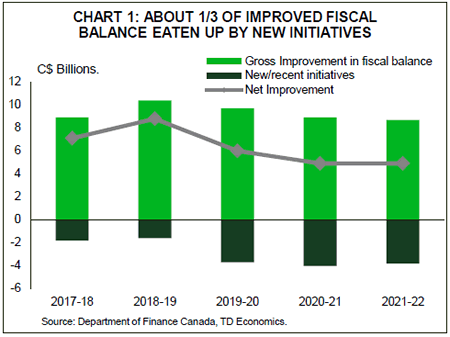
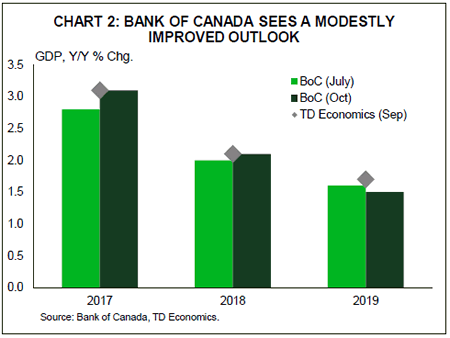
U.S.: Upcoming Key Economic Releases
U.S. FOMC Rate Decision
Release Date: November 1, 2017
Previous Result: 1.25%
TD Forecast: 1.25%
Consensus: 1.25%
The November FOMC meeting is likely to be uneventful, with rates unchanged and no substantive changes in language. That said, we see two-sided risks: more cautious language on the inflation outlook (dovish), and a signal about an incoming rate hike (hawkish). Given current market pricing for a December hike, we expect any hawkish tone in the statement to have a more modest impact than a dovish bias.
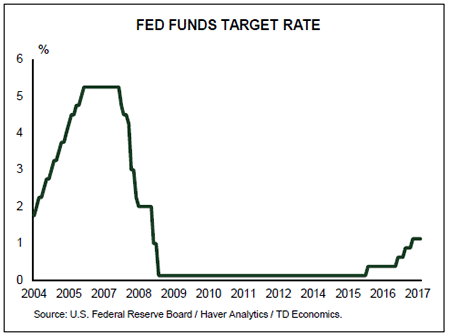
U.S. ISM Manufacturing Index – October
Release Date: November 1, 2017
Previous Result: 60.8
TD Forecast: 60.0
Consensus: 59.1
TD expects the ISM manufacturing PMI to slip back to 60.0, preserving some of its hurricane-induced strength as rebuilding efforts continue. Any correction is likely to be led by the supplier deliveries index, which surged after the hurricanes, and employment, which has been running at multi-year highs. Scope for a large correction is limited given the strength registered across regional surveys in October, notably the Philly Fed index.
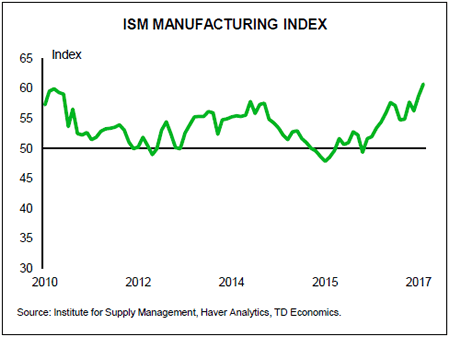
U.S. ISM Non-Manufacturing Index – October
Release Date: November 3, 2017
Previous Result: 59.8
TD Forecast: 57.5
Consensus: 58.0
ISM Non-Manufacturing Index is expected to pull back to 57.5, led also by a correction in supplier deliveries. That would leave the ISM composite above its Q3 average, consistent with solid above-trend GDP growth in Q4.
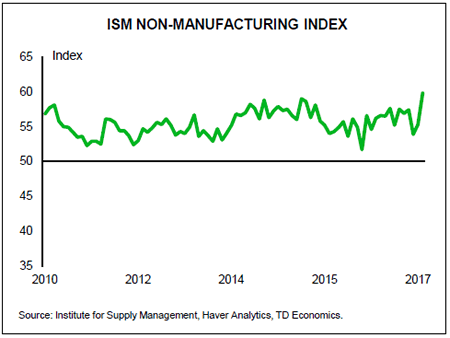
U.S. Employment – October
Release Date: November 3, 2017
Previous Result: -33k, unemployment rate 4.2%
TD Forecast: 330k, unemployment rate 4.2%
Consensus: 310k, unemployment rate 4.2%
We expect nonfarm payrolls to almost fully give back its hurricane-induced weakness and post a 330k gain. Uncertainty however is high with scope for surprise in either direction. Our forecast assumes that a 200k-250k drag from the twin hurricanes, which we expect to almost fully recover in October. Previous hurricane episodes, such as Katrina, suggest a full bounce back in payrolls could be delayed, yet we believe this experience is different given the trend in jobless claims which have fully recovered. With labour market indicators consistent with monthly payroll gains of 175-200k, October payrolls could easily print closer to +400k or higher. However, we are more cautious as the full rebound may not be realized until subsequent revisions, as was the case in previous natural disasters. In addition, September payrolls have potential to be upwardly revised.
We expect the unemployment rate to stabilize at 4.2%. Average hourly earnings is expected to print a relatively weak 0.2% m/m increase, though risk for a more modest 0.1% rise taking into account calendar effects and hurricane distortions. That would push the annual pace lower to 2.7% y/y, or 2.6% y/y if downside is realized.
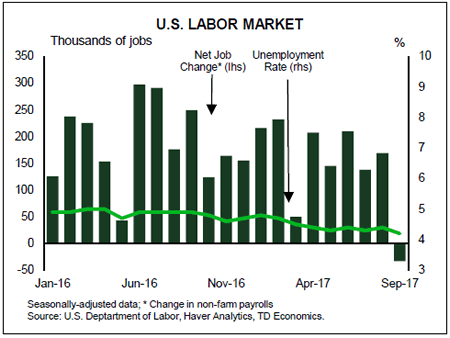
Canada: Upcoming Key Economic Releases
Canadian Real GDP – July
Release Date: October 31, 2017
Previous Result: 0.1% m/m
TD Forecast: 0.1% m/m
Consensus: 0.1% m/m
Industry-level GDP is forecast to rise by 0.1% in August, led by a rebound in the manufacturing industry. Retooling shutdowns at motor vehicle assembly plants single-handedly shaved nearly 0.1% from GDP in July and a partial rebound will provide a tailwind to growth in August. Outside of the manufacturing industry, growth conditions are far more mixed. Energy output may see a modest gain but utilities are likely to be a drag due to weaker demand caused by unseasonably cool weather. The services sector will be weighed down by a pullback in retail sales though broadening job growth suggests activity continues to increase. Our forecast for a 0.1% increase is consistent with Q3 growth in the low-to-mid 2% range, which presents upside risks to the Bank of Canada’s 1.8% projection from the October MPR. However, with the Bank focused on the supply side of the economy, we do not expect a modest upside surprise on GDP to change their bias and look for the next rate hike to come in January.
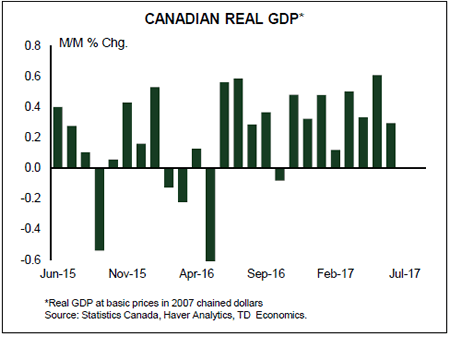
Canadian Employment – October
Release Date: November 3, 2017
Previous Result: 10k, unemployment rate: 6.2%
TD Forecast: 15k, unemployment rate: 6.2%
Consensus: 15k, unemployment rate: 6.2%
TD looks for the economy to add 15k jobs in October though the details may prove more encouraging than the headline print. After jumping to a 15-month high last month, we see more room for wage growth to rise in October due to a combination of favourable base-effects and the continued erosion of labour market slack. The unemployment rate is likely to hold at the current cycle low of 6.2% but the risks lean towards a further improvement to 6.1%. Meanwhile, the composition of job growth will likely skew towards services and private employment after an outsizde gain in public sector employment last month. The full/part-time split is likely to favour the latter given the underperformance so far this year, but we hope that outsized swings are in the past after the 100k swings in the last two reports. Youth participation and unemployment may also get more attention than usual given Poloz’s focus on remaining pockets of slack in the labour market.
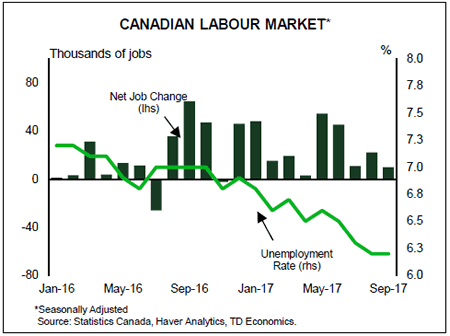
Canadian International Trade – September
Release Date: November 3, 2017
Previous Result: -$3.4bn
TD Forecast: -$3.0bn
Consensus: -$2.9bn
The goods trade deficit is forecast to narrow to $3.0bn in September, reflecting a moderate rebound in export activity while imports should see little change. Exports are likely to benefit from a rebound in auto production while vehicle replacement in Texas and Florida will add to foreign demand. The hurricane distortion in energy products is less clear cut but we expect an increase in petroleum exports to offset weaker demand from Gulf refineries. However, currency appreciation will continue to pose a risk. This will cap off a very weak quarter for Canadian exports after the soft handoff in June and a sharp decline in July. Even after a modest improvement in September, we look for trade to act as a sizeable headwind to growth in Q3.
